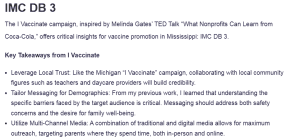IMC DB 3
The I Vaccinate campaign, inspired by Melinda Gates’ TED Talk “What Nonprofits Can Learn from Coca-Cola,” offers critical insights for vaccine promotion in Mississippi: IMC DB 3.
Key Takeaways from I Vaccinate
- Leverage Local Trust: Like the Michigan “I Vaccinate” campaign, collaborating with local community figures such as teachers and daycare providers will build credibility.
- Tailor Messaging for Demographics: From my previous work, I learned that understanding the specific barriers faced by the target audience is critical. Messaging should address both safety concerns and the desire for family well-being.
- Utilize Multi-Channel Media: A combination of traditional and digital media allows for maximum outreach, targeting parents where they spend time, both in-person and online.
Inspiration from Melinda Gates’ TED Talk
- Engage local influencers as Coca-Cola does with vendors to foster trust (Gates, 2010).
- Use real-time feedback to refine messaging dynamically.
- Incorporate culturally familiar symbols to enhance message resonance.
Stakeholders and Demographics in Mississippi
Jackson’s urban, multicultural population responds to messages emphasizing community welfare. Lafayette County’s rural, predominantly white population prioritizes personal freedom. Public health communicators must recognize these differences to craft messages that resonate.
How Differences Inform Messaging
In Jackson, stress community protection; in Lafayette, highlight individual choice and family safety. This tailored approach ensures greater message effectiveness.
Specific Audience for My Project
My final project targets vaccine-hesitant parents of daycare-age children in Mississippi. Notably, such parents are often concerned about vaccine safety due to misinformation. They care about their children’s well-being but are wary of potential risks. My campaign will address their fears with transparent, fact-based information delivered by trusted community figures.
Communication Messages
- Flyer: “Keep your children and community protected—vaccinate today. Visit your local clinic for safe and effective vaccines.”
- Social Media Post: “Vaccination is a choice to protect what matters most. #VaccinateMississippi #HealthyFamilies”
References
Gates, M. (2010, September). What nonprofits can learn from Coca-Cola [Video]. TED Talks. https://www.ted.com/talks/melinda_gates_what_nonprofits_can_learn_from_coca_cola
ORDER A PLAGIARISM-FREE PAPER HERE
We’ll write everything from scratch
Question 
Discussion posts should be 300 words (MAXIMUM) and should pull in at least 2 outside sources. You must also reply to two classmates’ posts to get full credit. Replies should be substantive and provide additional insights rather than simply writing “I agree with you. Good job.” At least one external citation should be present in each reply to a classmate so that it is evidence-based rather than just your opinion.
Week 3 Discussion Prompt
- When reading the I Vaccinate Silver Anvil submission, what stood out to you as 2-3 key takeaways for ideas that you might incorporate into your own project?
- The I Vaccinate social marketing campaign was based on a TED Talk by Melinda Gates “What Coca-Cola can learn from non-profits.” Watch that TED Talk linked on Blackboard, and list any ways that it inspires you in creating your own communication effort to encourage vaccination in Mississippi. (A bulleted list is fine).

IMC DB 3
- Consider different stakeholders within the state of Mississippi. Who are you talking to? Consider the different demographic/psychographic characteristics, based on data/external sources, of people in Jackson vs. Lafayette Co. for instance. What are some key differences/data points that a public health communicator would need to be aware of?How might these differences inform the direction of the public health communication effort, in order to create messages that truly resonate? Finally, narrow in on: Who am I talking to in MY final project? Which stakeholders in Mississippi, precisely, will my social marketing plan be targeted to? What do they care about?
- Create examples of 2 communication MESSAGES. Consider framing (look back at your supporting statements table from last week/Appendix 9 as a reference). For your chosen primary audience (listed above), create 1 message for a traditional media channel (e.g., radio, TV, newspaper, magazine, flyer,handout/brochure) and create 1 message for a digital channel (e.g., social media, email marketing, e-newsletter).
- You choose which channel, and briefly draft the message that you’d share, based on what we’ve learned so far, so that your classmates can provide you with helpful feedback. Consider these carefully, as you’ll include them in your final project.
Resource: